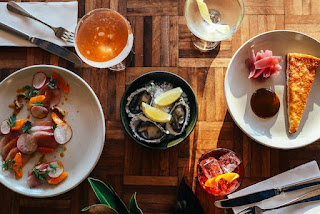Foods Containing High Zinc
Including foods that contain zinc in the daily diet is a way to meet daily zinc needs. The choices are quite varied, for example oysters, beef, edamame, eggs, spinach, and milk and other processed products.
 |
| 7 Foods Containing High Zinc |
Zinc is an important mineral that has many benefits for the body, namely increasing the body's immunity, accelerating wound healing, and reducing inflammation. Zinc supplementation is even included in the treatment of diarrhea in children.
Zinc is a mineral that cannot be produced by the body itself, so consuming foods containing zinc is necessary so that daily needs are met.
Food Choices that Contain Zinc
Everyone's zinc needs vary depending on age and gender. Adult women need 8 milligrams of zinc and adult men need 11 milligrams per day.
Zinc deficiency is often associated with hair loss, more rapid mood swings, loss of appetite, and diarrhea. Some food choices that you can consume are as follows:
1. Oysters
Oysters are a food source rich in zinc. In 1 oyster, it contains 5.5 milligrams of zinc. That is, the consumption of 1 oyster can meet half of the daily zinc needs of adults.
Apart from zinc, oysters also contain other nutrients, such as vitamin B12 and selenium which are also beneficial in boosting the body's immunity.
2. Beef
In every 100 grams of raw beef, contained 6.4 milligrams of zinc. As with oysters, the zinc levels in raw meat are quite high so consuming cooked beef can help meet the daily zinc needs of adults.
Even though it is high in zinc content, you still have to limit beef consumption. The reason is, consuming too much red meat can increase cholesterol levels which is associated with an increased risk of heart disease.
3. Nuts
For those who follow a vegan or vegetarian diet, daily zinc needs can be met by consuming beans, such as lentils, black beans, edamame and chickpeas. In 1 cup of lentils, for example, contains 2.5 milligrams of zinc.
Meanwhile, the zinc content in edamame, black beans and chickpeas reached 2.1 milligrams, 2 milligrams and 1.7 milligrams. Apart from containing zinc, nuts are also a low-fat food source that is high in protein, vitamins and fiber, thus bringing many health benefits.
4. Milk and its processed products
Not only is it high in calcium, milk and its processed products, such as yogurt cheese, also contain high zinc. In 1 cup of low-fat milk, contains about 1 milligram of zinc. Meanwhile, 1 cup of low-fat yogurt contains about 2.2 milligrams of zinc.
To increase the zinc content of milk or yogurt, you can add milk or yogurt to cereal, oats or other grains such as chia seeds, because cereals, oats and chia seeds also contain zinc.
5. Dark chocolate
You can also get the benefits of zinc just by eating dark chocolate. The thicker or higher the level of chocolate, the higher the zinc content.
In 100 grams of dark chocolate with chocolate content of 70-85%, contains 3.3 milligrams of zinc. This amount can meet 30% of the daily zinc requirement for adult men and 41% of the zinc requirement for adult women.
However, keep in mind, even though the zinc content in it is high, you need to be careful in choosing the type of chocolate. If you choose chocolate with low levels, the amount of zinc you get is certainly not as much as dark chocolate.
6. Eggs
The amount of zinc contained in 1 egg is not too much, namely around 1 milligram. However, you can still make it a food source that contains zinc.
The reason is, even though there is not as much zinc in eggs as in other foods, this type of food contains nutrients such as protein, healthy fats, B vitamins, selenium and choline, which are good for health.
7. Spinach
Spinach is a source of vegetable protein which also contains zinc. So, you can include this vegetable in your diet to help meet your daily zinc needs.
In addition to zinc, spinach contains other important minerals needed to carry out various body functions, such as maintaining blood sugar levels and maintaining heart health. Minerals contained in spinach include magnesium, manganese, iron, phosphorus and potassium.
To meet your daily zinc needs, you can also eat other zinc-containing foods, such as lamb, crab, shrimp, lobster, mushrooms, sesame seeds, pumpkin seeds, kale and broccoli.
However, remain wise in consuming any type of food. Consuming too many foods that contain zinc can also cause various kinds of complaints, such as nausea and vomiting, diarrhea, stomach cramps, or headaches.
In fact, too much zinc intake can also disrupt the absorption of copper and iron.
For those who suffer from certain medical conditions, such as food absorption disorders or prolonged diarrhea, consult your doctor first to get the dose of zinc intake that suits your needs.
Related Searches:
- which food is rich in zinc,
- what food has zinc in it,
- what food is high in zinc,
- where is zinc found in food,
- what food has zinc in them,
- what food is zinc in,
- which food can be transported in a zinc container,
- what food is rich in zinc,
- rich sources of iron, zinc, and b vitamins are commonly found in which food group?,
- what food are high in zinc,
- what food is highest in zinc?,
- what has zinc in food,
- zinc in which food,
- which food would be transported in a zinc container,
- what food is zinc found in,
- what food has the most zinc in it,
- what food high in zinc,


